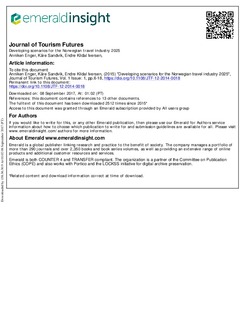| dc.contributor.author | Enger, Anniken | |
| dc.contributor.author | Sandvik, Kåre | |
| dc.contributor.author | Iversen, Endre Kildal | |
| dc.date.accessioned | 2017-09-08T08:07:20Z | |
| dc.date.available | 2017-09-08T08:07:20Z | |
| dc.date.created | 2014-09-15T11:25:18Z | |
| dc.date.issued | 2014 | |
| dc.identifier.citation | Journal of Tourism Futures. 2014, 1 (1), 6-19. | nb_NO |
| dc.identifier.issn | 2055-5911 | |
| dc.identifier.uri | http://hdl.handle.net/11250/2453683 | |
| dc.description.abstract | Purpose – The Norwegian travel industry faces decline in important international tourism segments and needs an industry-wide and future-oriented strategy to face these challenges. Accordingly, a common understanding of future drivers and different scenarios for the industry is needed. This paper seeks to address these issues. Design/methodology/approach – Using the process of scenario analysis and drawing on the involvement of the tourism industry, this paper describes the method, drivers, scenarios, and implications. Findings – The research identified six important drivers with predictable outcomes: uneven global economic development, digitalisation, climate change, consumer demand – return on time, centralisation, and demography. The Norwegian economy and Norwegian politics were the two drivers that stood out as the most significant for the tourism industry, with a very uncertain outcome, and constituted the two axes of the scenarios. This resulted in four scenarios: Money rules, The urban diamond, Opportunities for all, and Masterplan. Practical implications – The four scenarios represent different economic value of international tourism in Norway. The ‘‘Opportunities for all’’ and ‘‘Masterplan’’ scenarios represent the greatest economic value for Norwegian tourism. They indicate great opportunities for tourism to become the ‘‘new oil’’ in Norway if the oil economy declines. The two scenarios differ with respect to the degree of governance control vs market liberalisation. The scenarios will be used to identify implications and risks for different parts of the tourism industry, and to further explore how governance control and market liberalisation may be combined. Originality/value – The research identified six drivers which are significant for the Norwegian tourism industry. This resulted in four scenarios which are used to identify implications and risks for different parts of the industry. | nb_NO |
| dc.language.iso | eng | nb_NO |
| dc.relation.uri | http://www.etfi.eu/journal/journal-releases/volume-1-1-march-2014 | |
| dc.rights | Navngivelse 4.0 Internasjonal | * |
| dc.rights.uri | http://creativecommons.org/licenses/by/4.0/deed.no | * |
| dc.title | Developing scenarios for the Norwegian travel industry 2025 | nb_NO |
| dc.type | Journal article | nb_NO |
| dc.type | Peer reviewed | nb_NO |
| dc.description.version | publishedVersion | nb_NO |
| dc.source.pagenumber | 6-19 | nb_NO |
| dc.source.volume | 1 | nb_NO |
| dc.source.journal | Journal of Tourism Futures | nb_NO |
| dc.source.issue | 1 | nb_NO |
| dc.identifier.doi | https://doi.org/10.1108/JTF-12-2014-0018 | |
| dc.identifier.cristin | 1154445 | |
| dc.relation.project | Norges forskningsråd: 227026 | nb_NO |
| cristin.unitcode | 222,70,1,0 | |
| cristin.unitname | Institutt for strategi og økonomi | |
| cristin.ispublished | true | |
| cristin.fulltext | original | |
| cristin.qualitycode | 1 | |

